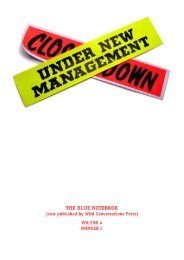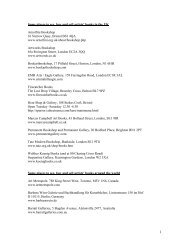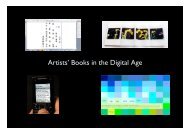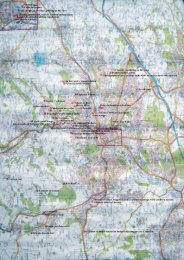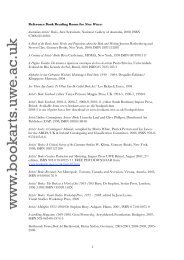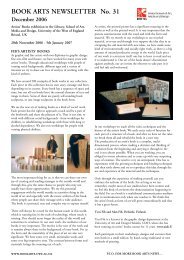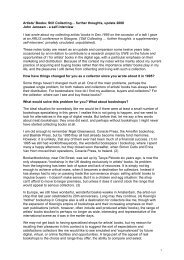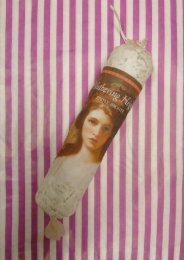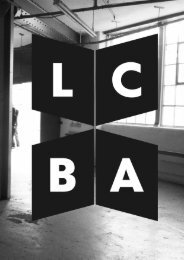Artist's Book Yearbook 2003-2005 - Book Arts - University of the ...
Artist's Book Yearbook 2003-2005 - Book Arts - University of the ...
Artist's Book Yearbook 2003-2005 - Book Arts - University of the ...
Create successful ePaper yourself
Turn your PDF publications into a flip-book with our unique Google optimized e-Paper software.
<strong>the</strong> assembly <strong>of</strong> poetic reflection achieves<br />
much. Several pages convey a sense <strong>of</strong> space<br />
with little more than a horizontal black line<br />
three-quarters <strong>of</strong> <strong>the</strong> way up <strong>the</strong> page. The<br />
background is on roughly marbled paper, with<br />
little broken-up mottlings <strong>of</strong> bright colour<br />
tapping in simple cues for space and<br />
atmosphere. McGarry works this (pretty good)<br />
trick in many <strong>of</strong> <strong>the</strong> pictures making up this<br />
book. The o<strong>the</strong>r one is to have swirly bits <strong>of</strong><br />
marbling filling up <strong>the</strong> whole picture plane<br />
(no horizon)- this becomes a subsurface space<br />
where <strong>the</strong> diving and bubbling goes on. My<br />
favourite page has <strong>the</strong> line “clouds in double<br />
surface” and separates two groups <strong>of</strong> puffy<br />
shapes with a horizontal line across <strong>the</strong> page.<br />
The basic background is (as throughout) on<br />
marbled paper, this time quite open with<br />
hundreds <strong>of</strong> small sky-blue marks. It achieves as<br />
good a feeling <strong>of</strong> a calm, open sea as I’ve seen<br />
anywhere.<br />
Investigating this paper again just now I got a<br />
bit <strong>of</strong> a shock: I had assumed that <strong>the</strong> various<br />
spreads in this concertina-format book were on<br />
seperate bits <strong>of</strong> marbled paper, selected for<br />
<strong>the</strong>ir appropriateness to individual pages.<br />
It’s actually on one continuous sheet: so <strong>the</strong><br />
artist has deliberately dipped <strong>the</strong> precise areas<br />
on <strong>the</strong> sheet into <strong>the</strong> differently-prepared<br />
marbling trays. I’d not suspected such a level <strong>of</strong><br />
organisation: <strong>the</strong> playful line and unique<br />
character <strong>of</strong> <strong>the</strong> books prepares one for<br />
something <strong>of</strong> a dashed-<strong>of</strong>f miracle. There’s still<br />
a lot <strong>of</strong> that to it: it takes tremendous poise, a<br />
clear vision and a good heart to plunge right in<br />
like this. It’s got that in common with Chinese<br />
brush painting. Every mark tells: no<br />
pentimenta. (In fact, regrets <strong>of</strong> any kind have<br />
no place in this book.) Preparing <strong>the</strong> paper like<br />
this ups <strong>the</strong> ante a little bit. To fail on this<br />
155<br />
surface would spoil <strong>the</strong> material and <strong>the</strong> effort<br />
would go in <strong>the</strong> bin. It also reveals more<br />
calculation in <strong>the</strong> effects achieved. Although<br />
<strong>the</strong> one-word review remains “charming”,<br />
I’ve got to look at <strong>the</strong> fact that <strong>the</strong> charm is<br />
intended. That <strong>the</strong> artist has been artful, ra<strong>the</strong>r<br />
than naive.<br />
These artful effects hold <strong>the</strong>ir own. The glow<br />
<strong>of</strong> <strong>the</strong> marbling and <strong>the</strong> swirling colours<br />
combined with <strong>the</strong> pouncing expressive line<br />
make several pages quite dramatic. I can’t<br />
get over <strong>the</strong> space that combining <strong>the</strong> two<br />
elements <strong>of</strong> <strong>the</strong> marbling and <strong>the</strong> inky line has<br />
produced. Ei<strong>the</strong>r one <strong>of</strong> <strong>the</strong>se elements on<br />
<strong>the</strong>ir own would tend towards a flattening<br />
effect. But in <strong>the</strong>se hands <strong>the</strong>y’ve been<br />
transformed.<br />
There’s an element <strong>of</strong> transformation in <strong>the</strong><br />
narrative as well. The rowing, diving (and, one<br />
feels, probably pic-a-nicking) figures aren’t<br />
clo<strong>the</strong>d: if this is happening <strong>of</strong>f <strong>the</strong> Irish coast<br />
<strong>the</strong>re’s gonna be shiverin’. Of course, it’d be<br />
daft to expect wetsuits. This is happening in a<br />
luminous world where <strong>the</strong> landmarks turn into<br />
chapters, <strong>the</strong> noticing <strong>of</strong> fish into events that<br />
penetrate with wonder. It’s a childlike view <strong>of</strong><br />
<strong>the</strong> world in some senses: although <strong>the</strong>re’s<br />
clearly adult wonder going on here too. In this<br />
way it’s a somewhat cinematic book. Shafts <strong>of</strong><br />
illumination peep through as we open up<br />
concurrent pages, and build up into a narrative<br />
space that we travel through (“row through”<br />
seems appropriate). And we get a nicely<br />
cinematic ending too. The inky camera pulls<br />
back and isolates <strong>the</strong> tiny boat on a vast surface,<br />
“huge swa<strong>the</strong>s <strong>of</strong> silver shadow”, <strong>the</strong>n pulls back<br />
fur<strong>the</strong>r, until our only connection is <strong>the</strong> sound<br />
we can still hear <strong>of</strong> <strong>the</strong> oars: “dip creak, dip<br />
creak” And fade out...<br />
I love this book even more for discovering that<br />
he meant it. What I mean is that I’d previously<br />
seen <strong>the</strong> effects and thought <strong>the</strong>m happy<br />
coincidences, or as wise choices <strong>of</strong> material at<br />
<strong>the</strong> most complex. But in reality this is a<br />
carefully-planned work that artfully arranges<br />
itself to produce <strong>the</strong> effects that we experience.<br />
It tells us that we can be aware <strong>of</strong> <strong>the</strong> world<br />
around us, and experience it in all it’s<br />
sensational vibrancy, and still use our awareness<br />
to make and think in articulate ways.




